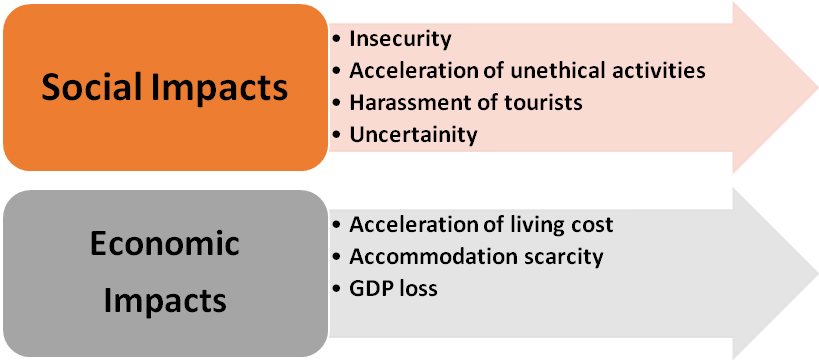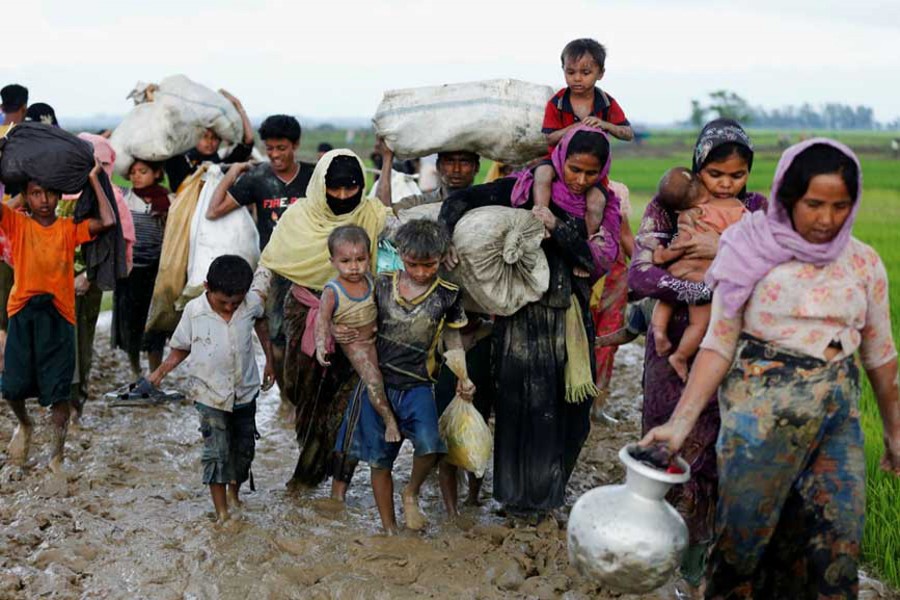Cox's Bazar is known for its share of importance in the arena of tourism in Bangladesh. It's a fishing port. The beach in Cox's Bazar is a sandy slope with an unbroken length of 155 km. It is the longest natural beach in the world. Cox's Bazar sprawls on 2491.85 Sq. km with a population of 2,289,990. The literacy rate is 39.3 per cent. Upazilas of Cox's Bazar districts are Chakaria, Cox's Bazar Sadar, Kutubdia, Moheshkhali, Pekua, Ramu, Teknaf and Ukhia. Cox's Bazar is one of the most beautiful and famous tourist spots in Bangladesh. The major source of Cox's Bazar economy is tourism. Millions of foreigners and Bangladeshi people visit this city every year. Around 500 hotels and guest houses in the district are dependent on tourism. People are also involved in fishing and collecting seafood and sea products for their livelihood. Oysters, snails, pearls and their ornaments are very popular with tourists. Some people are involved in transport business serving the tourists. Cox's Bazar is one of the few major spots for aquaculture in Bangladesh. Many people are involved in hospitality and customer service-orientated business.
A new problem has cropped up for the picturesque tourist town. Since outbreak of violence in Rakhine State of Myanmar on August 25 last year over 700,000 (7.0 lakh) Forcibly Displaced Myanmar Nationals (FDMNs) crossed the border into Cox's Bazar to escape persecution back at home. Reportedly some rebels attacked army and police posts in Rakhine, resulting in widespread violence, mass displacement of civilians and almost halt of aid activities. To save their lives people began fleeing to Bangladesh across the border. They joined the 300,000 people already staying in Bangladesh after fleeing persecution during earlier waves of displacement. Those displaced are concentrated in two upazilas-Ukhia and Teknaf, putting excessive pressure on infrastructure and services and also straining patience of the host population.
The FDMNs (Rohingya) are an ethnic group, the majority of whom are Muslims, who have lived for centuries in Buddhist-majority Myanmar. About 1.1 million Rohingya people are now displaced. The Rohingya Muslims are now described as 'the world's most persecuted minority'. The FDMNs (Rohingya) speak 'Rohingya' or 'Ruaingga'. There are 135 official ethnic groups in Myanmar but the Rohingya people are not considered one of them and have been denied citizenship in Myanmar since 1982. Thus they have been left stateless. Almost all of the Rohingya people in Myanmar lived in Rakhine state in the western coastal region and were not allowed to leave without government permission. They were underprivileged in the country lacking basic services and opportunities.
Muslims have lived in the area now known as Myanmar since as early as the 12th century, according to many historians and Rohingya groups. In November 2016, the United Nations accused the Myanmar government of carrying out ethnic cleansing against the Rohingya people. It was not the first time such an accusation was brought.
Bangladesh's tourism industry has been facing several challenges due to the Rohingya crisis. There are four main perspectives of the challenges: environment, health, society and economy. The extent of impact of such challenges will depend on how long they stay in Bangladesh.
FDMNs' temporary rehabilitation at different pockets mainly within Ukhia of Cox's Bazar and also in other upazilas of the district is leading to fallouts like cutting down trees, flattening hills, air pollution, water pollution and noise pollution. Moreover, due to the huge population, waste production is also increasing. Those waste products are also disposed of in the open. Furthermore, a large number of humanitarian relief vehicles are proving a wear-and-tear factor for the roads of Cox's Bazar. As the consequences, the ecological balance and bio-diversity of Cox's Bazar are being seriously hampered.

Figure shows underlying causes of environmental impacts of Rohingya influx on Cox's Bazar
Food, water and sanitation infrastructure has struggled to keep pace with the refugee population's health needs, leaving them vulnerable to infection. Some camps lack roads to carry in vital supplies and latrines to safely dispose of human waste. Few refugees have proper housing or protection from Bangladesh's frequent floods. Inadequate water and sewage infrastructure drives refugees to drink from pools contaminated by waste, spreading waterborne diseases like cholera. As FDMNs were underprivileged citizens in Myanmar, most of their children were not vaccinated. Flooding and limited shelters expose refugees to a booming mosquito population that can spread malaria. Widespread malnutrition will exacerbate risks of contracting diseases. According to a World Health Organisation (WHO) report in December 2017, diphtheria outbreak detected on November 8 2017 continued and reached its peak in mid-November 2017. These communicable diseases and health threats will drive down the number of tourist arrivals in Cox's Bazar.

Figure shows underlying causes of health issues' impacts on Cox's Bazar after the Rohingya influx
Social instability is growing in the areas sheltering the Rohingya people. Harassment of tourists and begging money by FDMNs increased at some tourist points of Cox's Bazar. Moreover, crime syndicates involved in Rohingya trafficking charge between Tk 20,000 and Tk 50,000 to smuggle out the FDMNs who are reluctant to stay in the camps. Women are more prone to trafficking. In the long run, it will create a bad impact on the tourism industry.

Figure shows causes of social and economic impacts of the Rohingya influx
In addition to regular tourists, a large number of others stay at Cox's Bazar before travelling to St. Martin's Island. Losing about more than a million tourists this season due to this risk is a great loss for the tourism industry. The other impacts are related to jobs in the tourism industry. FDMNs are involved in local tourism business at Cox's Bazar at wages below the standard. This creates a job crisis for the local community in Cox's Bazar. This influences the tourism industry indirectly. Moreover, officials from the government, non-government organisations (NGOs) and even foreign dignitaries are visiting Cox's Bazar to take stock of the Rohingya issues. This rush of people other than tourists raises the transport, accommodation and food costs in the district. So, recently the living cost increased and the accommodation problem intensified in Cox's Bazar. These are the direct and indirect effects of the Rohingya influx on the economy of the coastal district.
Following is the SWOT (strength, weakness, opportunity and threats) analysis of the current situation:
Strength
l Visit of local and foreign high officials may help solve this refugee problem
l International and national NGOs' activities highlighted this refugee problem
l The combined support of donors to the Rohingya increase economical activities
l Scope of inter-sectoral coordination build up
l Foreign aid
Weakness
l FDMNs are atomised, traumatised and angry
l Some Rohingya camps' locations are hard to reach
l Tensions are already rising between the host population and the refugees
l Trafficking and gender-based violence targeting women and children
l International engagement brings new and unpredictable risks
l Economic sector is affected by the influx
l Transit settlements have caused damage to environment
l A large number of relief vehicles on the roads are proving a substantial wear and tear factor on the roads
Opportunity
l International exposures create job opportunity and diversity
l NGO workforce working in a good network and collaboration
l Tourism Police capacity build-up
l Health surveillance system strengthening
l Solve the issue
Threats
l The economic impact of the tourism industry is usually assessed at the macroeconomic level. The most general measurement focuses on tourism receipts and the contribution of tourism to a country's GDP (gross domestic product).
l GNP (gross national product) also might be affected indirectly.
l Law enforcement deterioration
l Increased living cost
l Seasonal diseases
l Outbreak of diseases
l Upcoming cyclone season
l Extremism is a limited risk in the near term. FDMNs are unlikely targets for global jihadi groups.
l Humanitarian support will not continue for a long period.
l Length of stay of the FDMNs
Recommendations
l Large scale study is needed
l Develop intercommunal approaches
l Build up and increase tourism police capacity
l Increase human resources in all corresponding sectors
l Monitoring local markets more intensively
l Strengthening health surveillance system
l Need more focus on containment of any further outbreak
l Early preparedness for upcoming cyclone season
l Adequate and timely funding is required to make sure humanitarian needs are met
l Platforms such as UN and ASEAN should play a role in addressing the crisis
l Already the government of Bangladesh has started its diplomatic lobbying to solve the refugee crisis. However, it needs more energetic diplomacy, particularly with the regional partners to solve the problem.
Dr. Mohammad Ferdous Rahman Sarker, MBBS, MPH, M.Sc. is a Public Health Expert and Epidemiologist at the Directorate General of Health Services (DGHS).
Email: [email protected]


